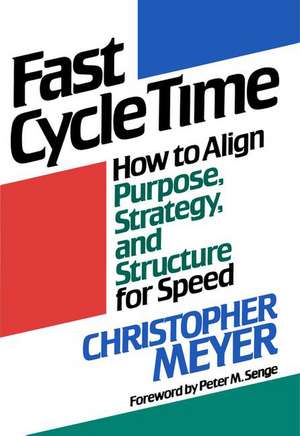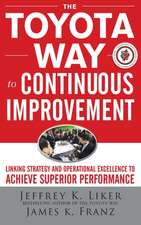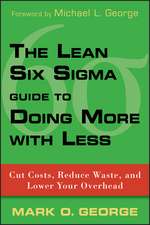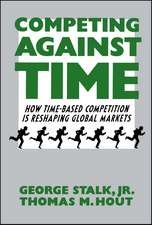Fast Cycle Time: How to Align Purpose, Strategy, and Structure for Speed
Autor Christopher Meyeren Limba Engleză Paperback – 6 sep 2007
Meyer argues that fast cycle time is achieved not by working faster, but by aligning the organization's purpose, strategy and structure. He demonstrates how the product development cycle must become a learning laboratory in which the four continuous elements "Design, Fabricate, Assemble, and Test" are analyzed with the intent to improve strategy in the next business cycle. Analyzing strategy and core processes enables management to detect and correct problems earlier, and leverage knowledge for improved innovation and increased value for customers.
Employing an ongoing case study, Core Products, Inc., throughout the text, Meyer shows how to redesign the organization for manufacturability and assembly, how to implement multifunctional teams that work, how to analyze and map critical cycle time interdependencies such as "co-location," and how to measure the impact of cycle time on business performance. Meyer's practical approach provides a simple methodology for organizations to deliver products to customers rapidly, accurately, and reliably.
"Chris Meyer interrelates many pieces that we have all read about in different places into a coherent guide to making it happen. Ironically, as Meyer shows, implementing fast cycle time means almost the opposite of what most American managers are inclined to do...Many years of practical experience have shown Meyer and his colleagues the wisdom of a paradox—that to speed up you often have to slow down."
—From the Foreword by Peter M. Senge
Preț: 122.91 lei
Nou
Puncte Express: 184
Preț estimativ în valută:
23.52€ • 24.47$ • 19.42£
23.52€ • 24.47$ • 19.42£
Carte disponibilă
Livrare economică 24 martie-07 aprilie
Preluare comenzi: 021 569.72.76
Specificații
ISBN-13: 9781416576242
ISBN-10: 141657624X
Pagini: 292
Dimensiuni: 152 x 229 x 20 mm
Greutate: 0.37 kg
Ediția:07000
Editura: Free Press
Colecția Free Press
ISBN-10: 141657624X
Pagini: 292
Dimensiuni: 152 x 229 x 20 mm
Greutate: 0.37 kg
Ediția:07000
Editura: Free Press
Colecția Free Press
Notă biografică
Christopher Meyer is the founder and Managing Director of the Strategic Alignment Group in Portola Valley, California, a rapidly growing management consulting firm with clients such as Ford Motor Company, Quantum Corporation, Procter & Gamble, and Glaxo lnc. He is also the creator of the California Institute of Technology seminar on time-based competition, the most widely attended public seminar of its kind.
Cuprins
Contents
Foreword by Peter M. Senge
Preface
PART ONE: FCT INTRODUCTION AND CORE CONCEPTS
1. Implementing Fast Cycle Time: The Simultaneous Act of Letting Go and Adding On
2. Be Fast or Be Last: The Competitive Mandate for Fast Cycle Time
3. Fast Cycle Time: The Basics
4. Systems and Organizational Learning: The Foundation for Fast Cycle Time
PART TWO: FCT IMPLEMENTATION
5. Strategic Alignment: Moving Up and to the Left
6. Structuring for Speed: Designing and Implementing Multifunctional Teams
7. FCT Process Redesign
8. Tools and Tactics to Speed Product Development
9. Implementation Dynamics and Measures
10. Leaders Pave the Road Ahead
Notes
Index
Extras
Chapter 1: Implementing Fast Cycle Time
The Simultaneous Act of Letting Go and Adding On
This book is a pragmatic guide for implementing a fast cycle time strategy (FCT). Authors such as Stalk and Hout provide the basic rationale for a fast cycle time strategy and demonstrate the dimensions of success possible. Yet they say relatively little about how to put their ideas into practice. Regrettably, far too many implementation efforts begin and end with an externally driven, expert analysis that identifies cycle time barriers and bottlenecks. The experts identify the problems but don't specifically define how to design and implement changes that create lasting improvement.
To transform a traditional organization into a fast cycle time competitor requires a systemic organizational change strategy combined with cycle time reduction methods and tools. The strategy has to define what the organization has to let go of as well as what it must simultaneously add to reduce cycle time. When top management actively leads this change process from within, cycle time reductions as high as 100% are possible. This book presents an implementation blueprint based on twenty years of hands-on experience in organizational change and re-design combined with five years experience implementing fast cycle time strategies. By focusing on implementation, we hope to give life to the basic concepts underlying FCT.
Fast cycle time implementation transforms the entire organization. Implementation is complete only when all those in the organization change their behavior and treat time as a valuable resource just as they would capital, technology, or people. To do this, they must first understand the value of FCT. Then they must have the skills and the tools to identify and pursue cycle time opportunities. All of this must be blended into a clear and simple change strategy that facilitates the letting go process. This book shows how to do that by:
1. Demonstrating how to transmit a systemic focus for speed through strategic alignment
2. Illustrating the importance of increasing the speed of organizational learning through redefining core work processes and structures
3. Defining how to create effective multi-functional teams that cut through organization "silos" or "chimneys"
4. Detailing how to analyze and redesign work for speed that uses the redesign process itself to create immediate improvements
5. Providing specific tactics for implementing fast cycle time in product development -- from product planning through the mass production ramp
6. Detailing the leadership behaviors necessary to implement FCT
7. Providing measurements that support and monitor fast cycle time implementation
This book also shows how to implement the "soft" elements of the fast cycle time strategy: strategy development, multi-function team effectiveness, process improvement, and empowerment. Although these issues may be less tangible, their impact is anything but soft. By using cycle time, which is considered "hard" by most managers, one can legitimately address the critical soft issues. As the reader will see, sustained cycle time improvement depends more on improving the firm's social architecture than its technological assets. This book provides tools for making these less tangible issues easier to address.
We will use product development as a focus because it and other forms of "knowledge work" have an enormous potential impact on profits and growth. Implementing fast cycle time in knowledge work has received significantly less attention by cycle time experts than the more tangible processes such as paper flow or manufacturing. Because the cycle time of knowledge work is often longer and the steps less tangible than manufacturing, it is harder to address. Our implementation framework for product development can be adapted to other forms of knowledge work, such as marketing. For those readers who need to reduce cycle time in downstream operations, all the techniques and models that apply to knowledge work can be applied with even greater ease to manufacturing, for example. It is much easier to transfer cycle time reduction processes designed for less tangible processes to those that are more tangible; however, the reverse is not true.
How to Read This Book
This book is divided into two sections. The first section provides the conceptual foundation of the FCT strategy, and the second focuses on implementation. If this is your first contact with the FCT strategy, we suggest you begin at the front. If you have a basic understanding of the concept and are focused on implementation, then you will want to skim this section and concentrate on the second one. Others may read as we do and selectively choose chapters that fit their particular needs. To facilitate that, the list below captures the essence of the remaining chapters.
Part 1
Chapter 2 -- Be Fast or Be Last: The Competitive Mandate for Fast Cycle Time. Why fast cycle time is a competitive requirement in the 1990s, how the rules have changed, and why moving FCT upstream into new product development provides a sustainable competitive advantage.
Chapter 3 -- Fast Cycle Time: The Basics. What fast cycle time is and is not, characteristics of world-class cycle time companies, and the internal and external benefits one can expect.
Chapter 4 -- Systems and Organizational Learning: The Foundation for Fast Cycle Time. Defines the paradigm shift required from traditional thinking and organizational models to support implementation.
Part 2
Chapter 5 -- Strategic Alignment: Moving Up and to the Left. Details how to create strategic alignment between purpose, strategy, and structure to enable speed at the working level; explains the role of executive management.
Chapter 6 -- Structuring for Speed: Designing and Implementing Multifunctional Teams. Details how to architect and implement multifunctional Teams including structure, reward systems, team development, and relationship to the functional organization.
Chapter 7 -- FCT Process Redesign. Details how to define, analyze, redesign, and implement new processes to increase the value-added time and reduce the non-value-added time.
Chapter 8 -- Tools and Tactics to Speed Product Development. Details specific tools and tactics for new product development that increase value-added time and increase the speed of learning.
Chapter 9 -- Implementation Dynamics and Measures. Details the implementation process and measures used to make FCT the way you manage your business.
Chapter 10 -- Leaders Pave the Road Ahead. Details the change process dynamics and the leader's role during the change process, followed by a closing summary.
Throughout we will refer to a running case study of Core Products' experience defining and implementing FCT, as well as multiple other examples. Let's get started.
Copyright © 1993 by Christopher Meyer
The Simultaneous Act of Letting Go and Adding On
This book is a pragmatic guide for implementing a fast cycle time strategy (FCT). Authors such as Stalk and Hout provide the basic rationale for a fast cycle time strategy and demonstrate the dimensions of success possible. Yet they say relatively little about how to put their ideas into practice. Regrettably, far too many implementation efforts begin and end with an externally driven, expert analysis that identifies cycle time barriers and bottlenecks. The experts identify the problems but don't specifically define how to design and implement changes that create lasting improvement.
To transform a traditional organization into a fast cycle time competitor requires a systemic organizational change strategy combined with cycle time reduction methods and tools. The strategy has to define what the organization has to let go of as well as what it must simultaneously add to reduce cycle time. When top management actively leads this change process from within, cycle time reductions as high as 100% are possible. This book presents an implementation blueprint based on twenty years of hands-on experience in organizational change and re-design combined with five years experience implementing fast cycle time strategies. By focusing on implementation, we hope to give life to the basic concepts underlying FCT.
Fast cycle time implementation transforms the entire organization. Implementation is complete only when all those in the organization change their behavior and treat time as a valuable resource just as they would capital, technology, or people. To do this, they must first understand the value of FCT. Then they must have the skills and the tools to identify and pursue cycle time opportunities. All of this must be blended into a clear and simple change strategy that facilitates the letting go process. This book shows how to do that by:
1. Demonstrating how to transmit a systemic focus for speed through strategic alignment
2. Illustrating the importance of increasing the speed of organizational learning through redefining core work processes and structures
3. Defining how to create effective multi-functional teams that cut through organization "silos" or "chimneys"
4. Detailing how to analyze and redesign work for speed that uses the redesign process itself to create immediate improvements
5. Providing specific tactics for implementing fast cycle time in product development -- from product planning through the mass production ramp
6. Detailing the leadership behaviors necessary to implement FCT
7. Providing measurements that support and monitor fast cycle time implementation
This book also shows how to implement the "soft" elements of the fast cycle time strategy: strategy development, multi-function team effectiveness, process improvement, and empowerment. Although these issues may be less tangible, their impact is anything but soft. By using cycle time, which is considered "hard" by most managers, one can legitimately address the critical soft issues. As the reader will see, sustained cycle time improvement depends more on improving the firm's social architecture than its technological assets. This book provides tools for making these less tangible issues easier to address.
We will use product development as a focus because it and other forms of "knowledge work" have an enormous potential impact on profits and growth. Implementing fast cycle time in knowledge work has received significantly less attention by cycle time experts than the more tangible processes such as paper flow or manufacturing. Because the cycle time of knowledge work is often longer and the steps less tangible than manufacturing, it is harder to address. Our implementation framework for product development can be adapted to other forms of knowledge work, such as marketing. For those readers who need to reduce cycle time in downstream operations, all the techniques and models that apply to knowledge work can be applied with even greater ease to manufacturing, for example. It is much easier to transfer cycle time reduction processes designed for less tangible processes to those that are more tangible; however, the reverse is not true.
How to Read This Book
This book is divided into two sections. The first section provides the conceptual foundation of the FCT strategy, and the second focuses on implementation. If this is your first contact with the FCT strategy, we suggest you begin at the front. If you have a basic understanding of the concept and are focused on implementation, then you will want to skim this section and concentrate on the second one. Others may read as we do and selectively choose chapters that fit their particular needs. To facilitate that, the list below captures the essence of the remaining chapters.
Part 1
Chapter 2 -- Be Fast or Be Last: The Competitive Mandate for Fast Cycle Time. Why fast cycle time is a competitive requirement in the 1990s, how the rules have changed, and why moving FCT upstream into new product development provides a sustainable competitive advantage.
Chapter 3 -- Fast Cycle Time: The Basics. What fast cycle time is and is not, characteristics of world-class cycle time companies, and the internal and external benefits one can expect.
Chapter 4 -- Systems and Organizational Learning: The Foundation for Fast Cycle Time. Defines the paradigm shift required from traditional thinking and organizational models to support implementation.
Part 2
Chapter 5 -- Strategic Alignment: Moving Up and to the Left. Details how to create strategic alignment between purpose, strategy, and structure to enable speed at the working level; explains the role of executive management.
Chapter 6 -- Structuring for Speed: Designing and Implementing Multifunctional Teams. Details how to architect and implement multifunctional Teams including structure, reward systems, team development, and relationship to the functional organization.
Chapter 7 -- FCT Process Redesign. Details how to define, analyze, redesign, and implement new processes to increase the value-added time and reduce the non-value-added time.
Chapter 8 -- Tools and Tactics to Speed Product Development. Details specific tools and tactics for new product development that increase value-added time and increase the speed of learning.
Chapter 9 -- Implementation Dynamics and Measures. Details the implementation process and measures used to make FCT the way you manage your business.
Chapter 10 -- Leaders Pave the Road Ahead. Details the change process dynamics and the leader's role during the change process, followed by a closing summary.
Throughout we will refer to a running case study of Core Products' experience defining and implementing FCT, as well as multiple other examples. Let's get started.
Copyright © 1993 by Christopher Meyer











